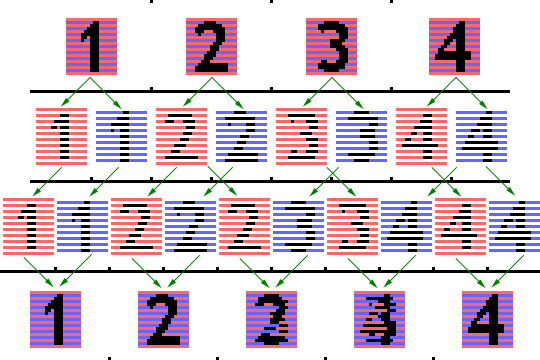Quote:
Originally Posted by laddie

is 1080i equivalent to 720p ??
|
No, it is not when 1080i is deinterlaced correctly to 1080p. It has twice the spatial resolution as 720p.
Table of Symbols
Equivalence
Statement
Classified as eather True or False, from this we build up
logic and can be represented on a
Truth Table using Boolean Logic with the following symbols.
- NOT p, ~p - One logical value
- Conjunction - AND
- Disjunction - OR
- Implication - p implies q, p → g
- Equality - p EQ g, p ⇔ q
- Disjunction - p XOR q, p+q
- NAND - p NAND q
- NOR - p NOR q
Commutative: (p and q) ⇔ (q and p), (p or q) ⇔(q or q)
Associative: [p and (q and r)] ⇔ [(p and q) and r], [p or (q or r)] ⇔ [(p or q) or r]
Distributive: [p and (q or r)] ⇔ [(p and q) or (p and r)], p or (q and r)] ⇔ [(p or q) and (p or r)]
Universal Quantifier, ∀ For all...
Existential Quantifier, ∃ There exists at least one...
Uniqueness Quantifier, ∃! There exists exactly one...
Set builder notation
the set of all elements x such that x...
{x:x > 0} or {x|x > 0}; the set of all x such that x is greater then 0.
Some common set operations on well defined sets A and B
Union: A ∪ B = {a : a∈A or a∈B}
Intersection: A ∩ B = {a : a∈A and a∈B}
Difference: A - B = {a : a∈A and a∉B}; EX: R \ Q = J
Relative Complement: A \ B = {a : a∈A and a∉B}; EX: R \ Q = J
Cartesian Product: A X B = {(a,b) : a∈A and b∈B}
Binary Relations
A realtionship between pairs of things. A
Binary Relation on set S is the set of all ordered pairs or the
Cartesian Product S^2 = SxS.
Functions and equivalence relations
The binary equivalence relation in Abstract Algebra: A
Subset R of a cartesian product of some set S, SxS. Read 'a is related to b by
R': a
Rb or a~b.
Reflexive: a
Ra for every a in S. ∀a∈S, (a,a)∈R. States that something is equal to itself.
Symmetric: if a
Rb, then b
Ra. ∀a,b∈S, (a,b)∈R → (b,a)∈R. Allows us to switch the left and right sides of an equation.
Transitive: if a
Rb and b
Rc, then a
Rc. ∀a,b,c∈S, (a,b)∈R and (b,c)∈R → (a,c)∈R. Tansfers along chains of realations.
EX: Let T be a set of rectangles in a place, define
R as the set
R = {(a,b): a∈T, b∈T, a and b are congruent}.
Reflexive, a
Ra is congruent to itself.
Symmetric, a and b, and b and a are congruent.
Transitive, a and c are congruent.
EX: Let L be a set of lines in a plane and define
R as the set
R = {(a,b): a,b∈L, a is perpendicular to b}.
L is not equivalant because it does not satisfy all three:
Reflexive, line a is not perpendicular to itself.
Symmetric, a and b, b and a are perpendicular.
Transitive, a and c are parallel.
EX: congruence mod 5.
a
Rb. a congruent to b(mod 5); b -a is divisible by 5; 5/b -a
Reflexive, 5/a-a=0
Symmetric, 5/b-a and 5/a-b since a-b= -(b-a)
Transitive, 5/b-a and 5/c-b and 5/c-a since c-a = (c-b)+(b-a)
Glossery
¬ - negation operator NOT ¬(¬A) ⇔ A, x ≠ y ⇔ ¬(x = y).
∧ - conjunction operator AND
∨ - disjunction operator OR
⊕ - XOR
∈ - is an element of.
∉ - is not an element of.
→ - implication, if … then. x = 2 ⇒ x^2 = 4.
⇔ iff, A is true if B is true and A is false if B is false, x+5 = y+2 ⇔ x+3 = y
a ~ b means (and equivalently
∀ - for all. Universal qunatification. ∀ x: P(x), ∀ n∈
N: n^2 ≥ n.
∃ - there exists. Existential quantification. ∃ n ∈
N: n is even.
∃! - there exists exactly one. Uniqueness qunatification. ∃! n∈
N: n + 5 = 2n.
∴ - therefore. All humans are mortal. Socrates is a human. ∴ Socrates is mortal
∵ - because; since. '3331 is prime ∵ it has no positive integer factors other than itself and one' (Wiki)
■ - Q.E.D.
De Morgan's Laws (E∪F)' = E'∩F', (E∩F)' = E'∪F'
¬(P∨Q) ⇔ (¬P) ∧ (¬Q)
¬(P∧Q) ⇔ (¬P) ∨ (¬Q)
Congruence
A similarity between objects, but not a complete equivalence. In geometry, two figures are congruent if they have the same shape and size.

Next Post
Equivlence: 720 and 1080i/p





































 Linear Mode
Linear Mode

